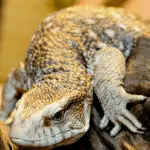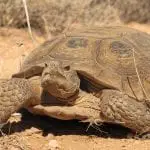Scientific Facts
| Common Name: | Rough Knob-Tailed Gecko |
| Scientific Name: | Nephrurus amyae |
| Life Span: | 8 to 12 years (in captivity) |
| Size: | 3 to 4 inches |
| Habitat: | Rock outcrops and crevices |
| Country of Origin: | Northern Australia |
Physical Description
The rough knob-tailed gecko is one of the known species of knob-tailed gecko. It is a heavy and sandy brown colored lizard with thick and bumpy skin. Like other knob-tailed geckos, this one is also known for its short tail that features bulbous additions that help the animal in distracting its prey. Of all knob-tailed geckos, the rough knob-tailed gecko has the biggest head and the smallest tail.
The rough knob-tailed gecko is a nocturnal animal. Many things are making it a good choice when it comes to a reptile pet.
Range
This lizard is native in the northern areas of Australia. The rough knob-tailed gecko is terrestrial as it lives in the inhabiting crevices and rock outcrops.
Habitat
In terms of habitat, the rough knob-tailed gecko chooses to live in the dry and deserted-style habitat that has more flat rocks and a hollow bark where it can hide when disturbed. It likes to spend time in a rocky area with more crevices where it can easily hide when predators are around.
Temperament and Handling
The rough knob-tailed gecko can tolerate handling. However, it’s not as tolerant as other types of geckos like the crested geckos and leopard geckos. Let the knob-tailed gecko walk through your hands for a short period. That is okay, but keeping the lizard out of the enclosure for hours may cause stress to the animal.
Some gecko species like N. wheeleri and Nephrurus levis may drop their tails when stressed, though they can regrow their tails. Other species, particularly the rough knob-tailed gecko can’t drop their tails. When feeling threatened, this gecko species roar and bark as a form of defense. Though it feels okay with touching, still, the rough knob-tailed gecko will feel better when kept inside the enclosure.
Venom and Bite
Generally, the rough knob-tailed gecko does not have venom or any kind of poison. Thus, this lizard can be a good pet for every reptile lover. This lizard is easy to take care of, as it does not show aggression. You just have to provide what the animal needs to keep it healthy, active, and happy.
The rough knob-tailed gecko does not bite humans. It can’t even cut the skin once it bites. You just need to take good care of the wound if your pet bites you. Treat the wound to prevent the spread of infection.
Reproduction
The rough knob-tailed gecko reaches maturity at the age of 1. The male lizard is a bit shorter than the female. It also has a two hemipenal swellings in the bottom of its tail, facing the vent.
Once conceived, the female rough knob-tailed gecko will lay its eggs during summer with two or more clutches that will come out in between 27 to 69 days. Typically, each clutch contains only 1 to 2 eggs.
Breeding
Breeding the rough knob-tailed gecko is pretty straightforward. The mating process will take place in the spring. When raised in captivity, the male lizard can live separated or along with the female in one enclosure. In that case, when mating is over, the female will lay its eggs either in its substrate or on the moist hide (if available). Once she lays the eggs, you can either collect the eggs and take care of them or leave them in the care of their parents.
If you choose to take good care of the eggs, then put them in a bit humid medium inside the deli cup. Incubate the eggs under the temperature of 82 degrees Fahrenheit. The eggs should hatch in about 60 to 80 days. Treat the hatchlings like their parents.
Rough Knob-Tailed Gecko as a Pet
This type of gecko is a good choice of pet if you love reptiles. With its calm nature, the rough knob-tailed gecko is quite interesting.
Diet
The rough knob-tailed gecko eats a variety of animals. If you keep it as a pet, you can feed it with crickets, cockroaches, ants, spiders, caterpillars, beetles, and scorpions. You can also feed it with small geckos and skinks. Some reptile owners feed this lizard with cockroaches and crickets 5x per week. A few out there feed it with mealworms. However, mealworms are not as tempting as other insects. The rough knob-tailed gecko may even refuse to take them.
Availability – Where to Get One?
Most species and even subspecies of knob-tailed geckos are in captivity for a long time. They are N. wheeleri, N. amyae, N. milii, and N. levis. If you like the rough knob-tailed gecko, then you can find it from a gecko breeder that specializes in these lizards. The knob-tailed geckos are hard to find due to rarity.
How to Care for a Rough Knob-Tailed Gecko?
If you had previous experience in taking care of geckos, then you can get it as a pet. You need to set up a dry habitat. A rough knob-tailed gecko loves a deserted-style habitat that has a hollow bark and a flat rock. Place a tiny water bowl within the cage once every week for just one day to make sure your pet is not getting dehydrated.
Caging
A knob-tailed gecko is best to keep separate from other geckos inside the enclosure. A 10-gallon terrarium or aquarium is enough for an adult rough knob-tailed gecko. However, since most keepers breed their pets, commercial rack systems can also be ideal to use. A baby gecko must be housed one by one.
The enclosure should have a hide box or two to offer security and shelter for the lizard. The hide boxes must err on the dark and small size instead of the open and large side. Also, it must have just one hole as entrance and exit. A plant saucer measuring 8 inches is good for adults. Hatchlings need a 6-inch saucer.
Temperature and Lighting
Since the rough knob-tailed gecko is a nocturnal animal, it doesn’t require overhead lighting or a basking light. This kind of lighting can even stress the lizard. Heating is better to apply by using a heating element. You can use the under tank heater for a terrarium or an aquarium. Heat cables and heat tape are great to use together with the rack systems.
Put the heating element on either the left or right side of the enclosure, not on the center. This way, your pet can pick the right spot depending on the climate. The temperature on the warm side of the enclosure must be between 87 and 89 degrees Fahrenheit.
Substrate
Fine-Grain sand is a good option for a substrate in keeping a rough knob-tailed gecko. Some species are known for their digging habits. These lizards create tiny tunnels and holes in their substrate. Slightly humid sand inside the enclosure can give the best conditions for those knob-tailed geckos, allowing them to dig out. Some other species, particularly the N. amyae, build enclosed environments within their hide boxes through plugging up the entryway using humid sand.
FAQ
What do rough knob-tailed geckos eat?
Rough knob-tailed geckos do not eat plants. They eat pests and other small insects instead.
Are rough knob-tailed geckos friendly?
They are calm. However, they don’t enjoy that much when being handled.
Do rough knob-tailed geckos love being handled?
The rough knob-tailed geckos are fine with short and infrequent handling. Prolonged handling stresses these animals.
Do rough knob-tailed geckos love being in groups?
Keeping them in groups can be okay, but males may become aggressive if they compete for one female. Keep them in pairs instead.
Are rough knob-tailed geckos dangerous to humans?
The rough knob-tailed geckos are not dangerous to humans. They don’t exude venom or any poisonous secretion.



